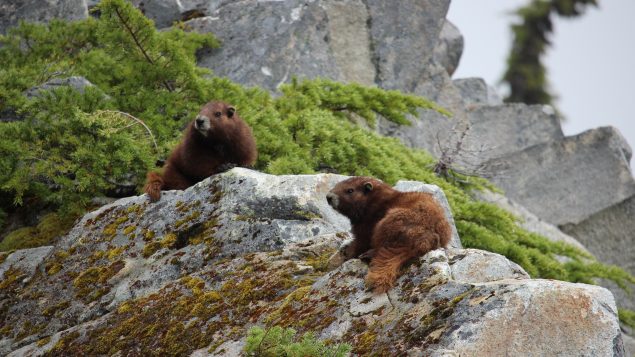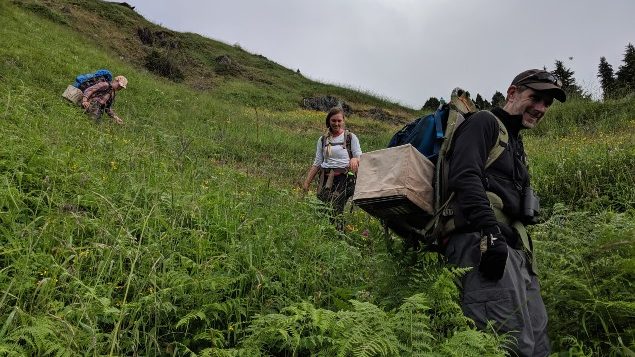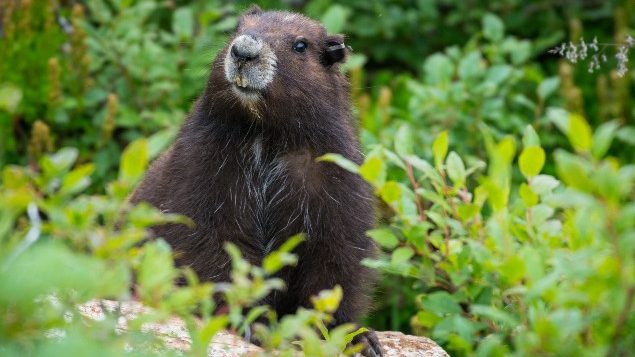There is a very special kind of marmot found only on Vancouver Island on Canada’s Pacific coast and it appears to have pulled back from the brink of extinction. The cat-sized mammals live in meadows at 1,000-1,500 meters elevation.
An ongoing decline of the animals in the 1990s and early 2000s reduced the population to fewer than 30 by 2003. By 2012, recovery efforts had boosted the population to between 200 and 250 individuals. Then a terrible drought that fall killed one-third of the animals leaving only about 150. Today, the population is back to between 200 and 250.
Vancouver marmot’s habitat is changing
Conditions are changing in the meadows where the marmots live and that is making it difficult for them to survive, according to Adam Taylor, executive director of the Marmot Recovery Foundation. In a phone conversation, he said that over the past years there has been less snow. Normally, a heavy snow pack in winter causes avalanches which clear out trees creating a marmot’s ideal meadow habitat. In this kind of landscape, the marmots get up on rocks to scout for predators like cougars, wolves and eagles. When they see them, they usually whistle to warn others and then scoot into burrows to hide. If there are no avalanches, and no clearing of the meadows, the predators have plenty of places to hide and capture the marmots. The lighter snow pack and faster melting of recent years also means that there is less water to replenish the meadow vegetation that provides food for the marmots.

Two one-year-old marmots in their typical habitat. Rocks provide a vantage point to scout for predators. (Hannah Sungaila/Marmot Recovery Foundation)
Repopulation may have helped
The marmots are slow to reproduce having only two to four pups every other year. The foundation has a captive breeding program and repopulated one area in 2007 with two or three animals and another in 2011 with about six. Subsequently, the researchers did not see the population growth they expected nearby, and were only alerted by hikers who happened to see marmots on a trail further away.
The foundation captures marmots and performs minor surgery on them to put small transmitters under the skin. Collars are not appropriate because the marmots’ weight varies considerably from when they are fattened up in the fall and when they emerge from their burrows after having hibernated through the winter. They also cannot have anything that sticks out of the skin because the site could get infected with dirt as they move through their burrows.
Researchers must avoid avalanches
The only kind of device that can be used does not transmit very far, so researchers have to get fairly close to be able to monitor the marmots. They either hike, ski, or snowshoe into the meadows depending on the weather, and if the snow is too deep, they occasionally go in by helicopter. They must be very careful to avoid avalanches.

Avalanches clear away trees creating good meadow habitats for marmots. (Adam Taylor/Marmot Recovery Foundation)
Two distinct populations of marmots, plus a back-up group
Marmots used to be more plentiful. There is evidence that there were in the past Indigenous cabins used for hunting them. After speaking with some Indigenous people, Taylor learned that marmots played an important spiritual role, but he declined to say anything more, not wanting to speak for them.
There are two distinct marmot populations on Vancouver Island. A small group of about 12 to 16 animals are kept in Clayoquot Provincial Park as insurance in case some disease or parasite wipes out the other two groups. There are three different species of marmots which live in other parts of Canada.
Vancouver Island Marmot Recovery Foundation gets two-thirds of its funding through private donations and the remainder from the private land owner of the areas and the government of the province of British Columbia.

Staff carry a marmot to its release site at Haley Bowl, British Columbia. (Mike Lester/Marmot Recovery Foundation)
“A team from the Marmot Recovery Foundation visits Mount Arrowsmith on Vancouver Island to study a growing colony of endangered marmots. Filmed as part of the Striking Balance documentary series, which explores Canada’s UNESCO biosphere reserves.” (YouTube)







For reasons beyond our control, and for an undetermined period of time, our comment section is now closed. However, our social networks remain open to your contributions.